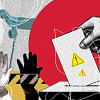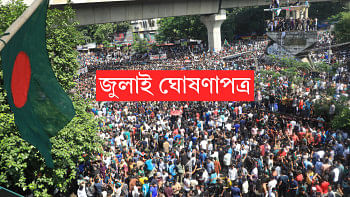Victim's fate still in debris
Rafiq Khan was working in the 'Ether Tex' garments factory located on the 6th floor of Rana Plaza when it collapsed. As the electricity went out, and as soon as the generator started, everything went black. When Rafiq opened his eyes, he found himself in the rubble. After 19 long hours, he was rescued.
His right leg was broken so badly that he is still in pain. The incident not only injured him physically but also mentally. He was so traumatised that he could not sleep at night. The memory of Rana Plaza would haunt him constantly and stop him from doing his regular work. He was scared of sounds that triggered memories of the collapse.
When the Rana Plaza disaster took place, I was working as a journalist for a television channel. I covered the deadly disaster from the very first day. It was a horrible experience, indeed, to see so many dead bodies, scarred faces, wounded body parts and the crying faces of the survivors under the collapsed roof. As a journalist, I had the advantage of going inside to see the real picture. I can recall that I could not eat during the day, nor sleep at night. Even after the rescue operations came to an end, I could not sleep for three/four months. When the deadly disaster comes to my mind, still, I see corpses, blood, families crying, survivors wailing… I can barely contain my emotions.
I underwent psychological treatment from a trained therapist. Despite having all the privileges of a middle-class background, the trauma of the incident still haunts me.
Even after three years of the incident, this is my situation. Can we even imagine what kind of problems a survivor like Raifiq has been facing?
Just a few days ago, I had a conversation with Rafiq. He said, "I still can't work properly. After Rana Plaza, I received payment for my treatment from many organisations. But these couldn't make me better. Now, I have to pay for my treatment. I can't sleep at night. I can't even think about going to the garment factory again."
Rafiq talked about how helpless he feels. He said, "After Rana Plaza, many people and institutions communicated with me. They gave me money in different phases, but I could not use it for generating income. Now, no one communicates with me." After the collapse, Rafiq received training on entrepreneurship, and with his saving and financial support from organisations, he established a business. But his mental and physical condition was such that he couldn't manage to run the business properly.
Rafiq is one example of the 2,500 survivors of Rana Plaza. According to a survey report of ActionAid Bangladesh titled 'Three Years Post Rana Plaza: Challenges in RMG Sector' published on 16 July, 2016, a majority of the survivors' situation is the same as Rafiq's: 58.4 percent survivors of the collapse are still traumatised and 48 percent of them remain unemployed due to physical and mental weakness even after three years of the tragedy. The report highlights our ignorance and irresponsible attitude towards the survivors and the family of the deceased.
This is the third consecutive survey of ActionAid Bangladesh. In 2016, the survey was conducted on over 1,300 survivors and 500 relatives of the deceased. The report provides us with some good news as well, such as that the physical condition of 78.8 percent of the 1,414 injured workers is improving. Meanwhile, 14.6 percent of the injured workers say they still have serious physical problems. Is it an acceptable outcome after three years?
I have been working on the Rana Plaza issue since the incident took place. I have talked with some physiotherapists and physiologists who are currently working with some of the survivors. According to them, survivors need continuous physiological and psychological support for 2-4 years. Without this support, survivors will not be able to deal with the trauma and it will continue to haunt them for the rest of their lives.
But the reality is, survivors do not have the luxury of taking care of and improving their mental and physical condition. On average, a survivor spends 61.1 percent on food, 15.5 percent on house rent, 12.4 percent on children's education and only 8.4 percent for treatment.
Survivors of Rana Plaza are finding it difficult to get jobs; they are still suffering from trauma; support from the responsible stakeholders seems to be on the decline. How then can a survivor dream of a better life? Who should take responsibility for their wellbeing?
Survivors have received financial support in different phases. However, while one might have received around Tk. 2 to 5 lakhs in compensation, someone else, with the same difficulties, got a lesser amount. There is still confusion regarding the actual compensation and its proper disbursement. The plan of disbursing compensation should include the long term economic, physical and psychological support of the survivors and the families of those who perished in this terrible disaster. Unfortunately, however, most of the survivors have only received temporary financial support without any long-term need assessment.
The initiatives taken by responsible stakeholders are usually separate or on an ad-hoc basis. And so we need to ensure that the initiatives are institutionalised. If we can formulate a legal framework, addressing issues like compensation, safety, security and compliance, stakeholders are bound to fulfil their responsibilities accordingly. We don't want any more Rafiqs to struggle through their life. We want survivors and the families of the deceased to live a normal life, a life that is not bereft of the financial, psychological or social security that they deserve.
The writer is a development worker and youth activist. Email: [email protected].

 For all latest news, follow The Daily Star's Google News channel.
For all latest news, follow The Daily Star's Google News channel. 








Comments